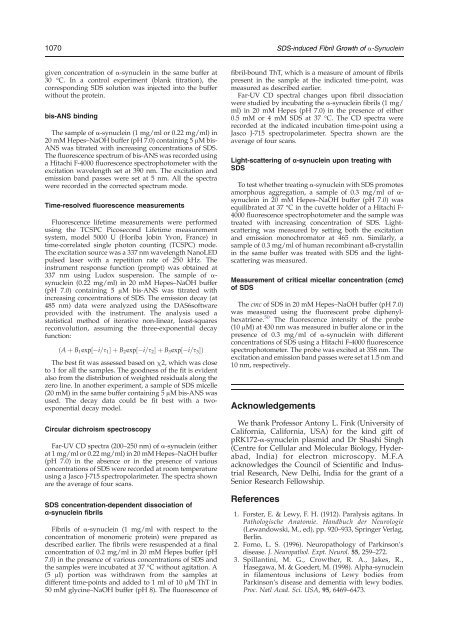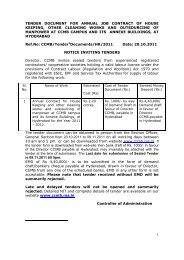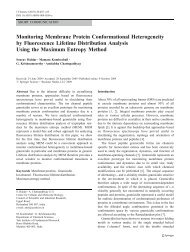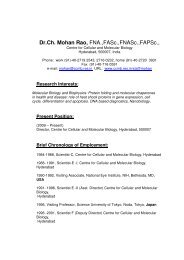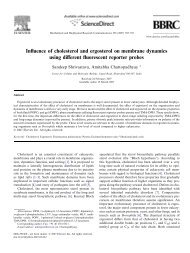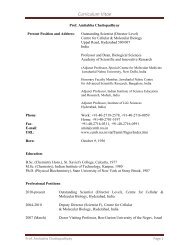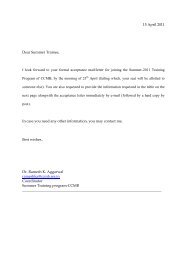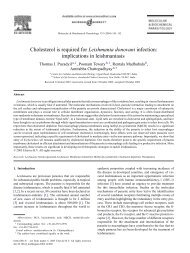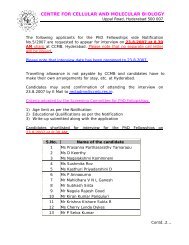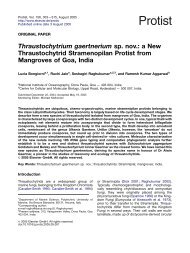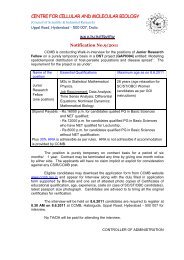1070 <strong>SDS</strong>-induced Fibril Growth <strong>of</strong> a-Synucleingiven concentration <strong>of</strong> α-synuclein in the same buffer at30 °C. In a control experiment (blank titration), thecorresponding <strong>SDS</strong> solution was injected into the bufferwithout the protein.bis-ANS bindingThe sample <strong>of</strong> α-synuclein (1 mg/ml or 0.22 mg/ml) in20 mM Hepes–NaOH buffer (pH 7.0) containing 5 μM bis-ANS was titrated with increasing concentrations <strong>of</strong> <strong>SDS</strong>.The fluorescence spectrum <strong>of</strong> bis-ANS was recorded usinga Hitachi F-4000 fluorescence spectrophotometer with theexcitation wavelength set at 390 nm. The excitation <strong>and</strong>emission b<strong>and</strong> passes were set at 5 nm. All the spectrawere recorded in the corrected spectrum mode.Time-resolved fluorescence measurementsFluorescence lifetime measurements were performedusing the TCSPC Picosecond Lifetime measurementsystem, model 5000 U (Horiba Jobin Yvon, France) intime-correlated single photon counting (TCSPC) mode.The excitation source was a 337 nm wavelength NanoLEDpulsed laser with a repetition rate <strong>of</strong> 250 kHz. Theinstrument response function (prompt) was obtained at337 nm using Ludox suspension. The sample <strong>of</strong> α-synuclein (0.22 mg/ml) in 20 mM Hepes–NaOH buffer(pH 7.0) containing 5 μM bis-ANS was titrated withincreasing concentrations <strong>of</strong> <strong>SDS</strong>. The emission decay (at485 nm) data were analyzed using the DAS6s<strong>of</strong>twareprovided with the instrument. The analysis used astatistical method <strong>of</strong> iterative non-linear, least-squaresreconvolution, assuming the three-exponential decayfunction:ðA þ B 1 exp½ i=s 1 ŠþB 2 exp½ i=s 2 ŠþB 3 exp½ i=s 3 ŠÞThe best fit was assessed based on χ2, which was closeto 1 for all the samples. The goodness <strong>of</strong> the fit is evidentalso from the distribution <strong>of</strong> weighted residuals along thezero line. In another experiment, a sample <strong>of</strong> <strong>SDS</strong> micelle(20 mM) in the same buffer containing 5 μM bis-ANS wasused. The decay data could be fit best with a twoexponentialdecay model.Circular dichroism spectroscopyFar-UV CD spectra (200–250 nm) <strong>of</strong> α-synuclein (eitherat 1 mg/ml or 0.22 mg/ml) in 20 mM Hepes–NaOH buffer(pH 7.0) in the absence or in the presence <strong>of</strong> variousconcentrations <strong>of</strong> <strong>SDS</strong> were recorded at room temperatureusing a Jasco J-715 spectropolarimeter. The spectra shownare the average <strong>of</strong> four scans.<strong>SDS</strong> concentration-dependent dissociation <strong>of</strong>α-synuclein fibrilsFibrils <strong>of</strong> α-synuclein (1 mg/ml with respect to theconcentration <strong>of</strong> monomeric protein) were prepared asdescribed earlier. The fibrils were resuspended at a finalconcentration <strong>of</strong> 0.2 mg/ml in 20 mM Hepes buffer (pH7.0) in the presence <strong>of</strong> various concentrations <strong>of</strong> <strong>SDS</strong> <strong>and</strong>the samples were incubated at 37 °C without agitation. A(5 μl) portion was withdrawn from the samples atdifferent time-points <strong>and</strong> added to 1 ml <strong>of</strong> 10 μM ThT in50 mM glycine–NaOH buffer (pH 8). The fluorescence <strong>of</strong>fibril-bound ThT, which is a measure <strong>of</strong> amount <strong>of</strong> fibrilspresent in the sample at the indicated time-point, wasmeasured as described earlier.Far-UV CD spectral changes upon fibril dissociationwere studied by incubating the α-synuclein fibrils (1 mg/ml) in 20 mM Hepes (pH 7.0) in the presence <strong>of</strong> either0.5 mM or 4 mM <strong>SDS</strong> at 37 °C. The CD spectra wererecorded at the indicated incubation time-point using aJasco J-715 spectropolarimeter. Spectra shown are theaverage <strong>of</strong> four scans.Light-scattering <strong>of</strong> α-synuclein upon treating with<strong>SDS</strong>To test whether treating α-synuclein with <strong>SDS</strong> promotesamorphous aggregation, a sample <strong>of</strong> 0.3 mg/ml <strong>of</strong> α-synuclein in 20 mM Hepes–NaOH buffer (pH 7.0) wasequilibrated at 37 °C in the cuvette holder <strong>of</strong> a Hitachi F-4000 fluorescence spectrophotometer <strong>and</strong> the sample wastreated with increasing concentration <strong>of</strong> <strong>SDS</strong>. Lightscatteringwas measured by setting both the excitation<strong>and</strong> emission monochromator at 465 nm. Similarly, asample <strong>of</strong> 0.3 mg/ml <strong>of</strong> human recombinant αB-crystallinin the same buffer was treated with <strong>SDS</strong> <strong>and</strong> the lightscatteringwas measured.Measurement <strong>of</strong> critical micellar concentration (cmc)<strong>of</strong> <strong>SDS</strong>The cmc <strong>of</strong> <strong>SDS</strong> in 20 mM Hepes–NaOH buffer (pH 7.0)was measured using the fluorescent probe diphenylhexatriene.50 The fluorescence intensity <strong>of</strong> the probe(10 μM) at 430 nm was measured in buffer alone or in thepresence <strong>of</strong> 0.3 mg/ml <strong>of</strong> α-synuclein with differentconcentrations <strong>of</strong> <strong>SDS</strong> using a Hitachi F-4000 fluorescencespectrophotometer. The probe was excited at 358 nm. Theexcitation <strong>and</strong> emission b<strong>and</strong> passes were set at 1.5 nm <strong>and</strong>10 nm, respectively.AcknowledgementsWe thank Pr<strong>of</strong>essor Antony L. Fink (University <strong>of</strong>California, California, USA) for the kind gift <strong>of</strong>pRK172-α-synuclein plasmid <strong>and</strong> Dr Shashi Singh(Centre for Cellular <strong>and</strong> Molecular Biology, Hyderabad,India) for electron microscopy. M.F.Aacknowledges the Council <strong>of</strong> Scientific <strong>and</strong> IndustrialResearch, New Delhi, India for the grant <strong>of</strong> aSenior Research Fellowship.References1. Forster, E. & Lewy, F. H. (1912). Paralysis agitans. InPathologische Anatomie. H<strong>and</strong>buch der Neurologie(Lew<strong>and</strong>owski, M., ed), pp. 920–933, Springer Verlag,Berlin.2. Forno, L. S. (1996). Neuropathology <strong>of</strong> Parkinson'sdisease. J. Neuropathol. Expt. Neurol. 55, 259–272.3. Spillantini, M. G., Crowther, R. A., Jakes, R.,Hasegawa, M. & Goedert, M. (1998). Alpha-synucleinin filamentous inclusions <strong>of</strong> Lewy bodies fromParkinson's disease <strong>and</strong> dementia with lewy bodies.Proc. Natl Acad. Sci. USA, 95, 6469–6473.
<strong>SDS</strong>-induced Fibril Growth <strong>of</strong> a-Synuclein10714. Arima, K., Ueda, K., Sunohara, N., Arakawa, K., Hirai,S., Nakamura, M. et al. (1998). NACP/alpha-synucleinimmunoreactivity in fibrillary components <strong>of</strong> neuronal<strong>and</strong> oligodendroglial cytoplasmic inclusions in thepontine nuclei in multiple system atrophy. ActaNeuropathol. (Berl), 96, 439–444.5. Wakabayashi, K., Hayashi, S., Kakita, A., Yamada, M.,Toyoshima, Y., Yoshimoto, M. et al. (1998). Accumulation<strong>of</strong> alpha-synuclein/NACP is a cytopathologicalfeature common to Lewy body disease <strong>and</strong> multiplesystem atrophy. Acta Neuropathol. (Berl), 96, 445–452.6. Weinreb, P. H., Zhen, W., Poon, A. W., Conway, K. A.& Lansbury, P. T., Jr (1996). A protein implicated inAlzheimer's disease <strong>and</strong> learning, is nativelyunfolded. Biochemistry, 35, 13709–13715.7. Uversky, V. N. (2002). What does it mean to benatively unfolded? Eur. J. Biochem. 269, 2–12.8. Jakes, R., Spillantini, M. G. & Goedert, M. (1994).Identification <strong>of</strong> two distinct synucleins from humanbrain. FEBS Letters, 345, 27–32.9. Iwai, A., Masliah, E., Yoshimoto, M., Ge, N., Flanagan,L., de Silva, H. A. et al. (1995). The precursor protein <strong>of</strong>non-A beta component <strong>of</strong> Alzheimer's disease amyloidis a presynaptic protein <strong>of</strong> the central nervoussystem. Neuron, 14, 467–475.10. Irizarry, M. C., Growdon, W., Gomez-Isla, T., Newell,K., George, J. M., Clayton, D. F. et al. (1998). Nigral <strong>and</strong>cortical Lewy bodies <strong>and</strong> dystrophic nigral neurites inParkinson's disease <strong>and</strong> cortical Lewy body diseasecontain alpha-synuclein immunoreactivity. J. Neuropathol.Expt. Neurol. 57, 334–337.11. Uversky, V. N., Cooper, E., Bower, K. S., Li, J. & Fink,A. L. (2002). Accelerated alpha-synuclein fibrillationin crowded milieu. FEBS Letters, 515, 99–103.12. Uversky, V. N., Li, J. & Fink, A. L. (2001). Evidence fora partially folded intermediate in alpha-synucleinfibril formation. J. Biol. Chem. 276, 10737–10744.13. Conway, K. A., Harper, J. D. & Lansbury, P. T., Jr(2000). Fibrils formed in vitro from alpha-synuclein<strong>and</strong> two mutant forms linked to Parkinson's diseaseare typical amyloid. Biochemistry, 39, 2552–2563.14. Conway, K. A., Lee, S. J., Rochet, J. C., Ding, T. T.,Williamson, R. E. & Lansbury, P. T., Jr (2000).Acceleration <strong>of</strong> oligomerization, not fibrillization, isa shared property <strong>of</strong> both alpha-synuclein mutationslinked to early-onset Parkinson's disease: implicationsfor pathogenesis <strong>and</strong> therapy. Proc. Natl Acad. Sci.USA, 97, 571–576.15. Conway, K. A., Harper, J. D. & Lansbury, P. T. (1998).Accelerated in vitro fibril formation by a mutantalpha-synuclein linked to early-onset Parkinson disease.Nature Med. 4, 1318–1320.16. Serpell, L. C., Berriman, J., Jakes, R., Goedert, M. &Crowther, R. A. (2000). Fiber diffraction <strong>of</strong> syntheticalpha-synuclein filaments shows amyloid-like crossbetaconformation. Proc. Natl Acad. Sci. USA, 97,4897–4902.17. Naiki, H., Higuchi, K., Matsushima, K., Shimada, A.,Chen, W. H., Hosokawa, M. et al. (1990). Fluorometricexamination <strong>of</strong> tissue amyloid fibrils in murine senileamyloidosis: use <strong>of</strong> the fluorescent indicator, thi<strong>of</strong>lavineT. Lab. Invest. 62, 768–773.18. Oberg, K., Chrunyk, B. A., Wetzel, R. & Fink, A. L.(1994). Native-like secondary structure in interleukin-1 beta inclusion bodies by attenuated total reflectanceFTIR. Biochemistry, 33, 2628–2634.19. Necula, M., Chirita, C. N. & Kuret, J. (2003). Rapidanionic micelle-mediated alpha-synuclein fibrillizationin vitro. J. Biol. Chem. 278, 46674–46680.20. Sharon, R., Goldberg, M. S., Bar-Josef, I., Betensky,R. A., Shen, J. & Selkoe, D. J. (2001). Alpha-Synuclein occurs in lipid-rich high molecular weightcomplexes, binds fatty acids <strong>and</strong> shows homology tothe fatty acid-binding proteins. Proc. Natl Acad. Sci.USA, 98, 9110–9115.21. Sharon, R., Bar-Joseph, I., Frosch, M. P., Walsh, D. M.,Hamilton, J. A. & Selkoe, D. J. (2003). The formation <strong>of</strong>highly soluble oligomers <strong>of</strong> alpha-synuclein is regulatedby fatty acids <strong>and</strong> enhanced in Parkinson'sdisease. Neuron, 37, 583–595.22. Perrin, R. J., Woods, W. S., Clayton, D. F. & George,J. M. (2001). Exposure to long chain polyunsaturatedfatty acids triggers rapid multimerization <strong>of</strong> synucleins.J. Biol. Chem. 276, 41958–41962.23. Jensen, P. H., Nielsen, M. S., Jakes, R., Dotti, C. G. &Goedert, M. (1998). Binding <strong>of</strong> alpha-synuclein tobrain vesicles is abolished by familial Parkinson'sdisease mutation. J. Biol. Chem. 273, 26292–26294.24. Davidson, W. S., Jonas, A., Clayton, D. F. & George,J. M. (1998). Stabilization <strong>of</strong> alpha-synuclein secondarystructure upon binding to synthetic membranes.J. Biol. Chem. 273, 9443–9449.25. Eliezer, D., Kutluay, E., Bussell, R., Jr & Browne, G.(2001). Conformational properties <strong>of</strong> alpha-synucleinin its free <strong>and</strong> lipid-associated states. J. Mol. Biol. 307,1061–1073.26. Perrin, R. J., Woods, W. S., Clayton, D. F. & George,J. M. (2000). Interaction <strong>of</strong> human alpha-Synuclein<strong>and</strong> Parkinson's disease variants with phospholipids.Structural analysis using site-directed mutagenesis.J. Biol. Chem. 275, 34393–34398.27. Jo, E., McLaurin, J., Yip, C. M., St. George-Hyslop, P. &Fraser, P. E. (2000). alpha-Synuclein membrane interactions<strong>and</strong> lipid specificity. J. Biol. Chem. 275,34328–34334.28. Zhu, M. & Fink, A. L. (2003). Lipid binding inhibitsalpha-synuclein fibril formation. J. Biol. Chem. 278,16873–16877.29. Ch<strong>and</strong>ra, S., Gallardo, G., Fern<strong>and</strong>ez-Chacon, R.,Schluter, O. M. & Sudh<strong>of</strong>, T. C. (2005). Alphasynucleincooperates with CSPalpha in preventingneurodegeneration. Cell, 123, 383–396.30. Bisaglia, M., Tessari, I., Pinato, L., Bell<strong>and</strong>a, M.,Giraudo, S., Fasano, M. et al. (2005). A topologicalmodel <strong>of</strong> the interaction between alpha-synuclein<strong>and</strong> sodium dodecyl sulfate micelles. Biochemistry,44, 329–339.31. Lee, J. C., Langen, R., Hummel, P. A., Gray, H. B. &Winkler, J. R. (2004). Alpha-synuclein structures fromfluorescence energy-transfer kinetics: implications forthe role <strong>of</strong> the protein in Parkinson's disease. Proc. NatlAcad. Sci. USA, 101, 16466–16471.32. Ulmer, T. S., Bax, A., Cole, N. B. & Nussbaum, R. L.(2005). Structure <strong>and</strong> dynamics <strong>of</strong> micelle-boundhuman alpha-synuclein. J. Biol. Chem. 280, 9595–9603.33. Lee, H. J., Choi, C. & Lee, S. J. (2002). Membraneboundalpha-synuclein has a high aggregation propensity<strong>and</strong> the ability to seed the aggregation <strong>of</strong> thecytosolic form. J. Biol. Chem. 277, 671–678.34. Lee, E. N., Lee, S. Y., Lee, D., Kim, J. & Paik, S. R.(2003). Lipid interaction <strong>of</strong> alpha-synuclein during themetal-catalyzed oxidation in the presence <strong>of</strong> Cu 2+ <strong>and</strong>H 2 O 2 . J. Neurochem. 84, 1128–1142.35. Narayanan, V. & Scarlata, S. (2001). Membranebinding <strong>and</strong> self-association <strong>of</strong> alpha-synucleins.Biochemistry, 40, 9927–9934.36. Munishkina, L. A., Phelan, C., Uversky, V. N. &Fink, A. L. (2003). Conformational behavior <strong>and</strong>


